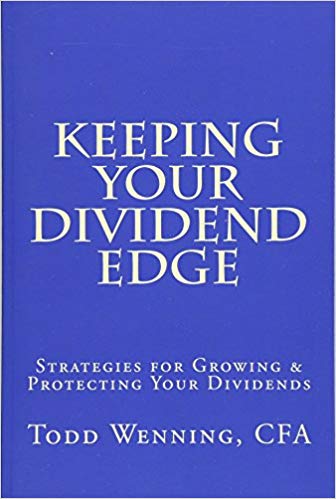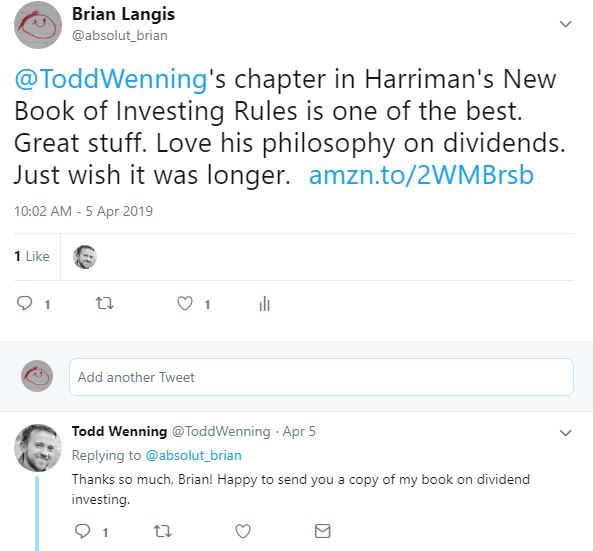
Before I get to the book I want to share a little story. Something positive actually happened on Twitter. It turns out that Twitter doesn’t have to be carnage pit filled with trolls. There’s a nice guy on it and his name is Todd Wenning (@ToddWenning).
A while back I read Harriman’s New Book of Investing Rules. The book is 500 pages of wisdom by some great investors. There are some well-known names and less familiar names like Todd. The investors profiled range in style and strategies. One of the articles in the book was written by Todd Wenning (@ToddWenning). I really enjoyed Todd’s piece and I reached out to him on Twitter to let him know.

Todd was a man of his tweet. I did received his book, Keeping Your Dividend Edge, and I was more than happy to read it. See, something positive came out of Twitter.
I like Todd’s philosophy on investing and dividends. His thinking really resonated with me. Invest like you are buying a business. Study the business, study the fundamentals, figure out the competitive advantage, and can you make a reasonable assumption that the company will be able to maintain its success for a decade or more to come. Focus on the long-term and get paid in growing dividends and capital appreciation.
Todd’s book is about dividend investing. It’s a short read with approximately 120 pages. There’s nothing wrong with a small read. It’s actually refreshing. The book doesn’t waste your time. It’s delivers on content. It goes straight to the point. It’s concise and clear. Just the plain blue cover signals no b.s., no hype.
You will become a better investor if you read this book and actually apply it’s principles. You will. Todd didn’t reinvent the wheel here. Dividend investing has been a staple strategy. But what Todd did is to remind us of the art of dividend investing.
I feel that dividend investing is a lost art. Or investing for income in general. Most income investors are doing it wrong. It’s like health. Everybody wants to be fit and healthy but they are doing it wrong by buying into trends and taking short-cuts. I feel it’s the same with income/dividend investing. People are approaching it the wrong way.
Investors are turned off by blue chips dividend payers because of the low ~2% yield so they chase high-yield stocks. We live in a world where investors are buying bonds for capital gains. The world has turned upside down. The most probable cause is the 10-year plus of ultra low interest rates is distorting financial markets. It’s been a tough stretch for savers in need of yield. Another cause is buybacks as the preferred way to return money to investors.
You can’t just invest for the dividend. If you don’t do your homework it could led to trouble. Dividends should be part of a grander strategy. A good strategy should include dividends as a part of total performance. It’s a key component of long-term share price movements. You can’t guarantee a dividend because a company doesn’t have to pay one, but with the right analysis you can have pretty good idea if they will pay one and raise it over time. If you aim for let’s say a conservative 6% to 7% annual return (S&P Index has returned 10%+ in the last ten years). With a 3% yield you have accomplished half your returns. One aspect of dividends I like is that it’s a tangible returns. It’s a real return. It’s real cash that you receive. And I like cash because it allows me to allocate more capital.
Dividend investing is about patience. Focus on the long-term. Focus on the business. Focus on the fundamentals. Focus on the cash flow because that’s where dividends are from. Dividends need to come from cash produced by the company (not accounting earnings).
Dividends are not a magic pill. A company can’t guarantee a dividend because unlike a bond, there’s no obligation to pay. Dividends can be cut. We have seen blue chips like GE, Pfizer, and more recently Vodafone slash their dividends. A company might take on too much debt and get in trouble. The share price of the company you invested in can languish, or worse disappear. Taxes could be an issue if not handle properly. Todd’s book has a whole chapter on avoiding dividend cuts. Usually the main reason is the lack of sustainable free cash flow. If a company can’t covert a dividend with free cash flow, they need to fund the payouts with cash on hand, debt, or asset sales. Expect trouble if that happens.
The holy-grail of dividend investing success is the compounding effect. The combination of the increased in value of your stock (capital gain), dividends, and growing dividends reinvested that creates bigger dividends, that gets reinvested can turn your investment into a snowball what creates wealth.
In case it wasn’t clear by now Todd makes the case for smart dividend investing. In case you need to read it again, if you want success in the stock market you need a long-term patient approach. Dividends helps you focus on the business. It helps you focus on the fundamentals of the business. It helps you forget about the daily gyrations of the stock market. I have no clue what the stock market is going to do, so it would be more profitable to forget it and concentrate on trying to find the right stock to buy. Dividends also help you take hit. If you have an investment that is down 15% (because it happens) and the business is sound, you have your dividends coming in and an opportunity to buy the business 15% cheaper.
Long-term thinking, patience, and persistence are qualities which should pertain to investors. Dividends delivers on these fronts. Keeping Your Dividend Edge deserved a place on your investing book shelf.
Enjoy!
Brian
 I enjoyed reading
I enjoyed reading 